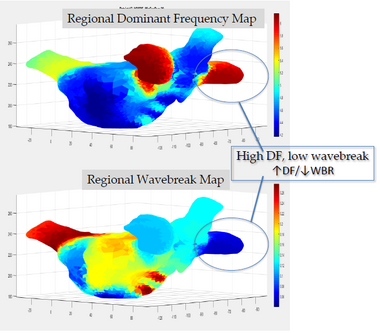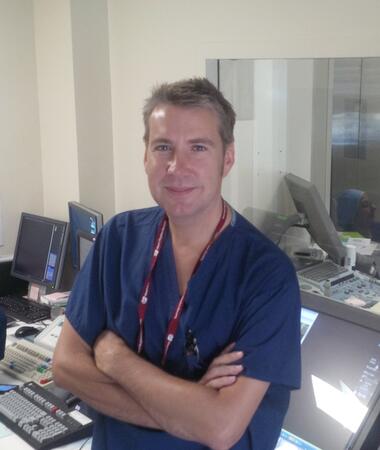Queen’s University researchers have gained recognition for the discoveries they have made in medicine, engineering, and the sciences; innovations that have improved the lives of people around the world. To make sure that the university and the public continue to benefit from this work, Queen’s Partnerships and Innovation (QPI) promotes the discoveries of university researchers who have assigned their intellectual property to Queen’s and whose work is ready for licensing and commercial application. QPI leads the commercialization processes, including the protection of the intellectual property, the creation of strategies to further its development, the search for funders, partners, and licensees, the negotiation of terms, the management of relationships, the collection of licensing and royalty revenues, and their disbursement to inventors.

The image on the computer screen seems to be a great storm, something like a hurricane, spiraling across the surface of… Earth? A distant planet?
Try the human heart. And that storm is a computer-enhanced image of what is termed wave break. This jarring electrical disturbance is what happens on the surface of our hearts when we suffer from what is known as atrial fibrillation. Because this phenomenon is intimately connected with the danger of stroke and heart failure, it is something to be prevented. To do this, specialized cardiologists perform an ablation. They insert a catheter through a vein and literally burn the areas of the heart where the fibrillations occur, to stop them from happening. Effective but it also kills that section of the heart wall. So, very important to get it right. The image on the computer screen was generated through a new approach for detecting wave break, invented by Dr. Damian Redfearn, a clinician and professor of cardiac electrophysiology in the School of Medicine at Queen’s University, and his colleague, Dr Mohammad Hassan Shariat, an engineer and computer scientist. This innovation pinpoints precise areas of the heart where fibrillations originate, which makes treating them more effective and safer.
In March 2022, Dr. Redfearn’s revolutionary software passed one of the key milestones on the path to the day when his technology will help heart patients to lead longer, healthier lives. The United States Patent Office granted a patent for his invention.

Thanks in no small part to the efforts of Queen’s Partnerships and Innovation. As part of its mandate to promote the discoveries of university researchers, QPI’s staff members include patent agents to help with a process that can be complicated and time-consuming (Dr. Redfearn’s began with the filing of a first U.S. patent application in September 2017). Dr. Stephen Scribner (Director, Intellectual Property) and Angela Lyon draft patent applications which they file and prosecute in the Canadian and the United States patent offices. Depending upon the invention, they also work on international patent applications under the Patent Cooperation Treaty (PCT) where protection in other jurisdictions is desired. Both Scribner and Lyon have strong science backgrounds and technical areas they focus on in the patent process.
The United States patent for Dr. Redfearn’s invention was just one of a number of notable patents granted to Queen’s University for the 2021-2022 fiscal year, ending April 30, 2022. During that 12-month period, Queen’s was granted a total of 28 patents, including 14 in the United States, 7 in Canada, 2 in Europe, 3 in India, and 1 in Australia. An additional five U.S. patents were granted to companies that work with QPI, the applications for which were drafted and filed by QPI’s Patent Team as one of many services that QPI may provide, with support from FedDev Ontario (FDO) and as part of the university’s community engagement strategy, to eligible startups and SMEs in Eastern Ontario. During the same 12-month period, QPI filed 44 patent applications for Queen’s inventions, and an additional 18 on behalf of companies involved in QPI’s FDO-enabled programs. While the 2022-23 fiscal year is not yet complete, QPI’s Patent Team has already drafted and filed 13 new U.S. patent applications, including 3 for startups under the FDO programs. The team has also filed 18 additional patent applications in the U.S. and Canada and 4 PCT applications. In addition, 23 patents have been granted, including 18 U.S.; another 3 U.S. patents will be granted by the end of the fiscal year.
Whereas the grant of a patent for an invention derived from research is desirable, it is not the end result. Rather, it is one very important step on the road from idea to realized product. The term “intellectual property” is often used for the products of research, even seemingly ephemeral products like ideas. And the key point about an idea that has been developed and patented is that it becomes a piece of property, no less than real estate is, and can be sold or rented (licensed) in much the same way. QPI staff includes three partnerships development officers, each with different areas of expertise in science and engineering, who are working to commercialize the university’s patented inventions and are also assisting companies under the FDO program. Commercialization of Dr. Redfearn’s patented invention, just one of a number that he is working on, aims to license it to a firm that can take it to markets, including hospitals across North America, perhaps even worldwide.
The story of RockMass Technologies, a company with strong roots at Queen’s University, is a great example of the commercialization process at work. The initial research was carried out by Joshua Marshall, a Queen’s professor who holds appointments in the Faulty of Engineering and Applied Science. Dr. Marshall, along with PhD student Marc Gallant, developed a technology that allows a user to map discontinuities in rock quickly and accurately, which greatly improves safety and efficiency for those working in the mining industry. Dr. Marshall disclosed this invention to QPI staff who undertook the initial patent work – a first U.S. application was drafted and filed in 2015 followed by an international patent application in 2016 – and facilitated a novel commercialization strategy, which enabled a group of Queen’s students who were part of the Dunin-Deshpande Queen’s Innovation Centre Summer Initiative program to secure an option to license the technology. The students founded and incorporated RockMass Technologies, which incubated at Queen’s Innovation Park and received support from QPI and its partners in the local innovation ecosystem, attracted investment, and ultimately moved their company to Toronto. Today, RockMass sells its technology around the world. To date, Queen’s has obtained patents in the U.S., China, Australia, and South Africa, and has a pending application in Canada, all of which are licensed to RockMass. QPI’s patent and commercialization teams continue to support the company’s commercialization and expansion efforts.
In the 2021-2022 fiscal year, QPI negotiated additional license agreements with several third parties, providing them with exclusive or non-exclusive rights to various technologies in the Queen’s IP portfolio, including three Kingston-based companies: Spectra Plasmonics, DigiQ Power, and Tecta-PDS, now IDEXX Tecta. Visit QPI’s website to read recent articles on Spectra Plasmonics and DigiQ Power, and to view other Queen’s technologies available for license.
It's common to see the word “protection” used when talking about patents. But it’s also good to see a patent in terms of benefits. To be sure, the innovator benefits, as does the university. But the benefits extend far beyond that. Because patents hold out the hope of inventors being rewarded for innovation and they act as a strong disincentive to competitors who might want to copy an invention, they spur constant new development and innovation. More, they also extend to all of us who may benefit from patented inventions.
Readers interested in licensing or learning more about Queen’s patents and patented technology should contact Queen’s Partnerships and Innovation.
The programs and services provided to the companies referenced above have been enabled with support from Queen’s and funding from the Federal Economic Development Agency for Southern Ontario under the Scale-Up Platform Project, led by Invest Ottawa in eastern Ontario, which includes Queen’s, Launch Lab, and St. Lawrence College as regional partners, and/or the Health Innovation Kingston (HI YGK) Project, which is led by the City of Kingston and includes Queen’s as a local partner, along with St. Lawrence College, the Kingston Economic Development Corporation, and the Kingston Health Sciences Centre.
 About Vice-Principal Research
About Vice-Principal Research